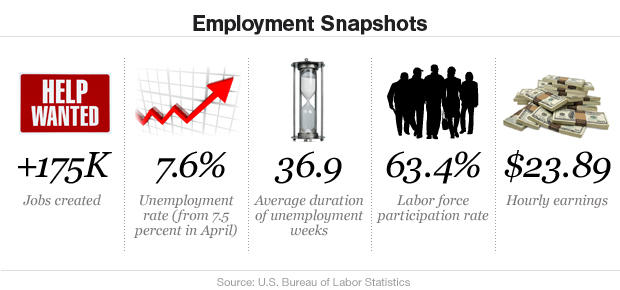Job growth rises slightly in May
(MoneyWatch) The U.S. economy added 175,000 jobs in May, in line with expectations and a sign that the labor market is holding up despite the impact of government spending cuts.
The unemployment rate ticked up to 7.6 percent, up from 7.5 percent last month, the U.S. Labor Department said Friday in releasing its monthly labor update. The agency revised downward its estimate for March and April, with the economy adding 12,000 fewer jobs than previously forecast.
The biggest jobs gains were in professional and business services, food services and drinking places, and retail. The manufacturing sector shed jobs for a third straight month. Non-farm payroll gains have averaged 196,000 jobs through the first four months of the year, including 165,000 in April.
- U.S. economy added 165K jobs in April
- Poll: More Americans have a positive view of the economy
- Wealth of most Americans down 55 percent since recession
U.S. stock futures were down slightly ahead of the start of trade as investors waited for the latest employment report. Trading has been volatile this week as mixed economic data suggest that the job-creation may be slowing down.
Financial markets may take comfort in the latest labor snapshot. Stronger job growth might have led investors to assume that the Federal Reserve would move to taper its massive bond purchases, which have helped push stocks to an all-time high, as early as this month. But the more middling pace of job-creation suggests that the Fed is unlikely to move before September or later.
Despite the solid job gains, the economy is hitting a soft patch after expanding at an annualized rate of 2.4 percent in the first three months of the year. That was expected, as the sequester -- the massive government spending cuts that took effect in March after Congress failed to reach a fiscal deal -- hinders growth.
"The impact of the sequester, whether real or feared, is making itself felt," said Ian Shepherdson, chief economist with Pantheon Macroeconomics, in a research note ahead of the jobs report. He added that the "outlook for employment growth over the next couple of months has taken a marked turn for the worse."
Federal government employment fell by 14,000 jobs in May and has lost 45,000 jobs over the past three months.
Economists forecast GDP growth in the second quarter to come in at under 2 percent. Consumer spending, factory output and other key measures of economic activity all point to a slowdown for the period.
That dip may be temporary, with economic signals suggesting a modest pick-up in growth in the second half of the year. The economy grew at a moderate pace across most of the U.S. between mid-April and June, according to data this week from Federal Reserve regional banks.
By some measures, the economy is clearly gaining strength. The total net worth among U.S. households recently topped $70 trillion, a record, as home prices have rebounded, stocks surged and Americans shed debt. Personal spending has remained strong, with consumers shrugging off a January hike in payroll taxes. The housing market, the most important source of wealth for millions of Americans, is also expected to continue recovering from its financial crisis-era lows.
Most economists expect GDP, the total value of goods and services, to expand this year between 2 and 2.5 percent.
Those positive trends bode well for next year, according to IHS Global Insight. "All this adds up to growth in the 3-3.5 percent range for most of 2014 -- once the headwinds from fiscal austerity and weak global growth diminish," economists with the research firm said in a note.
Before the release of Friday's job figures, research firm Macroeconomic Advisers was projecting unemployment to fall to 7.3 percent by year-end and to 6.8 percent in the fourth quarter of 2014.
As the labor market has gradually improved, a growing number of Americans seem more upbeat about the economy. A new CBS News/New York Times poll shows that 39 percent of respondents rate the economy as "good," the highest level since late 2007.
Still, 60 percent say it remains in bad shape. And for many people, times remain tough. Some 11.8 million people remain unemployed. Another 10 million are working part-time when they would rather be in full-time positions, or have stopped looking for a job altogether. The number of employed adults relative to the working-age population has hardly budget over the last year, underlining the frustratingly slow rebound in job-creation.
Another area of concern -- the quality of jobs the economy is creating. Most of the work that has come back since 2009, when the recession officially ended, has been lower-wage. Meanwhile, the sequester could harm nearly 2 million workers who receive emergency unemployment aid under a federal program for people who are no longer eligible for state jobless benefits, according to the National Employment Law Project.
Editor's note: CBS MoneyWatch initially published an Associated Press story on the employment report, which we have since replaced with this staff-written article. You can find the initial AP report and reader comments here.
